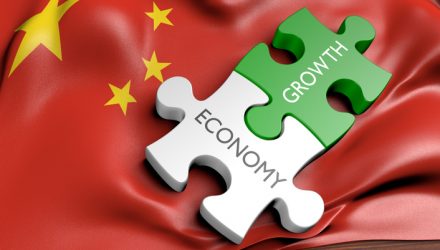China has been a major contributor to global growth, and its economic activity tends to have significant repercussions for the global economy. To understand where the Chinese economy is in its growth cycle, the two charts below are perhaps the only charts one needs.
Chinese Economy Health Check: PMIs

Source: Bloomberg. Data as of December 31, 2019. Data for Caixin Manufacturing PMI was not available prior to December 2016. Past performance is no guarantee of future results. Chart is for illustrative purposes only.
Purchasing managers’ indices (PMIs)1 are a better indicator of the health of the Chinese economy than the gross domestic product (GDP) number, which is politicized and is a composite in any case. The manufacturing and non-manufacturing, or service, PMIs have been separated in order to understand the different sectors of the economy. These days, the manufacturing PMI is the number to watch for cyclicality. China’s latest activity gauges remained in expansion zone. Its economy benefitted from past stimulus and the Phase One trade deal’s boost to sentiment (the new export orders PMI turned positive for the first time since May 2018). However, it is too early to talk about withdrawing policy support—especially for smaller privately-owned firms. For starters, the Caixin manufacturing PMI—which has a larger share of private companies—showed no improvement in December. Within the official PMI, the gauge for small companies moved deeper into contraction zone (in sharp contrast with large and medium-size enterprises).
Understanding the Credit Cycle: Non-SOE Borrowing Costs

Source: UBS. Data as of December 2, 2019. Past performance is no guarantee of future results. Chart is for illustrative purposes only. Spreads are measured relative to average yield of 1, 3, 5, and 10-year bonds issued by the China Development Bank.
As with any economy, central bank policy is very important in China. In this chart, we can see that interest rates for the private sector fluctuate, whereas the interest rates paid by state-owned enterprises (SOEs) are pretty stable. Therefore, to understand the credit cycle, we point your attention to this private sector, or non-SOE, interest rate. It spiked in 2018, as a result of China’s crackdown on shadow banking2, meaning tougher lending conditions for the private sector. These interest rates began trending down in the winter of 2018 as the “drip stimulus” appeared to take effect.
High funding costs for smaller firms are often cited as a key reason that stifles their growth. In our view, there is no doubt that discontinuing artificial “life support” (with resulting higher default rates) and reducing shadow financing contributed to this situation over the past year and a half. Additional policy initiatives may help at the margin— the most recent ones include a new Securities Law, a blanket 50bps reserve requirements cut effective January 6 (to “nudge” larger banks to provide more credit to smaller corporate clients) and the central bank’s decision to re-benchmark outstanding loan rates to Loan Prime Rate (LPR). However, we believe the longer-lasting solution can only come via structural reform and greater transparency, which may make it easier for investors to assess corporate credit risks.
DEFINITIONS AND DISCLOSURES
1 Purchasing managers index (PMI) is an economic indicator derived from monthly surveys of private sector companies. A reading above 50 indicates expansion, and a reading below 50 indicates contraction.
2 Shadow banking comprises private credit intermediation occurring outside the formal banking system.
Please note that Van Eck Securities Corporation (an affiliated broker-dealer of Van Eck Associates Corporation) offer investment products that invest in the asset classes discussed in this commentary.
This is not an offer to buy or sell, or a solicitation of any offer to buy or sell any of the securities mentioned herein. The information presented does not involve the rendering of personalized investment, financial, legal, or tax advice. Certain statements contained herein may constitute projections, forecasts and other forward looking statements, which do not reflect actual results, are valid as of the date of this communication and subject to change without notice. Information provided by third party sources are believed to be reliable and have not been independently verified for accuracy or completeness and cannot be guaranteed. The information herein represents the opinion of the author(s), but not necessarily those of VanEck.
All investing is subject to risk, including the possible loss of the money you invest. As with any investment strategy, there is no guarantee that investment objectives will be met and investors may lose money. Diversification does not ensure a profit or protect against a loss in a declining market. Past performance is no guarantee of future results.







